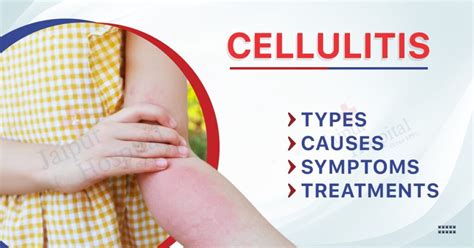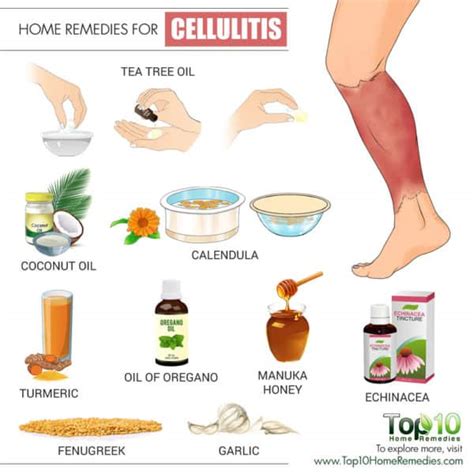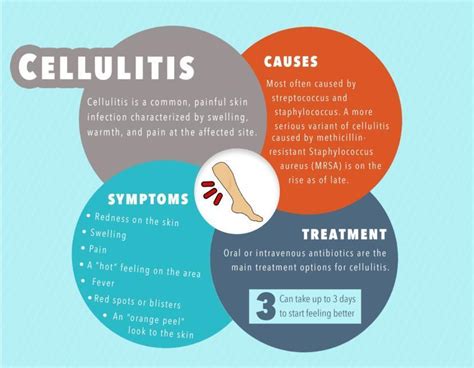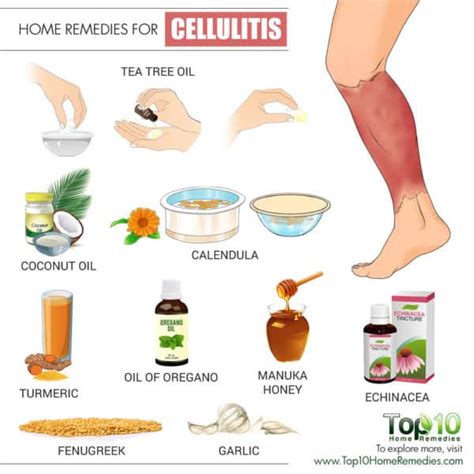Intro
Discover 5 ways to treat cellulitis, a bacterial skin infection, using antibiotics, wound care, and natural remedies, alleviating symptoms like redness, swelling, and pain, promoting skin health and preventing complications.
Cellulitis is a common bacterial skin infection that can cause redness, swelling, and pain in the affected area. It typically occurs when bacteria enter the skin through a crack or break, and can spread quickly if left untreated. Cellulitis can be treated with antibiotics, but there are also several home remedies and self-care techniques that can help to alleviate symptoms and promote healing. In this article, we will explore five ways to treat cellulitis, including medical treatments, home remedies, and lifestyle changes.
Cellulitis is a serious infection that requires prompt medical attention. If left untreated, it can lead to serious complications, such as abscesses, blood poisoning, and even death. However, with proper treatment, most people can recover from cellulitis and prevent future infections. It's essential to understand the causes, symptoms, and treatment options for cellulitis to ensure effective management and prevention.
The importance of treating cellulitis cannot be overstated. Cellulitis can affect anyone, regardless of age or health status, and can have severe consequences if left untreated. In addition to medical treatment, there are several lifestyle changes and home remedies that can help to alleviate symptoms and promote healing. By understanding the different treatment options and taking steps to prevent infection, individuals can reduce their risk of developing cellulitis and ensure effective management if they do become infected.
Understanding Cellulitis

Symptoms of Cellulitis
The symptoms of cellulitis can vary depending on the severity of the infection and the individual's overall health. Common symptoms include redness, swelling, and pain in the affected area, as well as fever, chills, and fatigue. In severe cases, cellulitis can cause abscesses, blood poisoning, and even death.Medical Treatments for Cellulitis

Antibiotic Treatment for Cellulitis
Antibiotic treatment for cellulitis typically involves a course of oral or intravenous antibiotics, depending on the severity of the infection. The most common antibiotics used to treat cellulitis are penicillin, amoxicillin, and clindamycin. It's essential to complete the full course of antibiotic treatment, even if symptoms improve before finishing the medication.Home Remedies for Cellulitis

Self-Care Techniques for Cellulitis
Self-care techniques, such as getting plenty of rest, staying hydrated, and eating a healthy diet, can also help to promote healing and alleviate symptoms. It's essential to avoid scratching or rubbing the affected area, as this can cause further irritation and delay healing.Lifestyle Changes to Prevent Cellulitis

Practicing Good Hygiene to Prevent Cellulitis
Practicing good hygiene is essential to preventing cellulitis. This includes washing the skin regularly with soap and water, especially after exercising or engaging in activities that can cause skin irritation. Individuals should also avoid sharing personal items, such as towels or razors, and avoid close contact with people who have skin infections.Natural Remedies for Cellulitis

Using Tea Tree Oil to Treat Cellulitis
Tea tree oil has antibacterial properties that can help to kill the bacteria causing cellulitis. To use tea tree oil, individuals can apply a few drops to the affected area, using a cotton swab or clean cloth. However, it's essential to dilute the tea tree oil with a carrier oil, such as coconut or olive oil, to avoid skin irritation.Conclusion and Next Steps

We invite you to share your thoughts and experiences with cellulitis in the comments below. Have you or a loved one been affected by cellulitis? What treatments or remedies have you found to be most effective? By sharing your story, you can help to raise awareness and support others who may be struggling with this condition.
What are the symptoms of cellulitis?
+The symptoms of cellulitis include redness, swelling, and pain in the affected area, as well as fever, chills, and fatigue.
How is cellulitis treated?
+Cellulitis is typically treated with antibiotics, which can help to kill the bacteria causing the infection. In addition to antibiotics, medical treatments for cellulitis may include pain management, wound care, and supportive care, such as rest and hydration.
Can cellulitis be prevented?
+Yes, cellulitis can be prevented by practicing good hygiene, avoiding close contact with people who have skin infections, and avoiding sharing personal items, such as towels or razors. Additionally, individuals can reduce their risk of developing cellulitis by managing underlying health conditions, such as diabetes, and avoiding activities that can cause skin irritation, such as excessive sun exposure or extreme temperatures.
